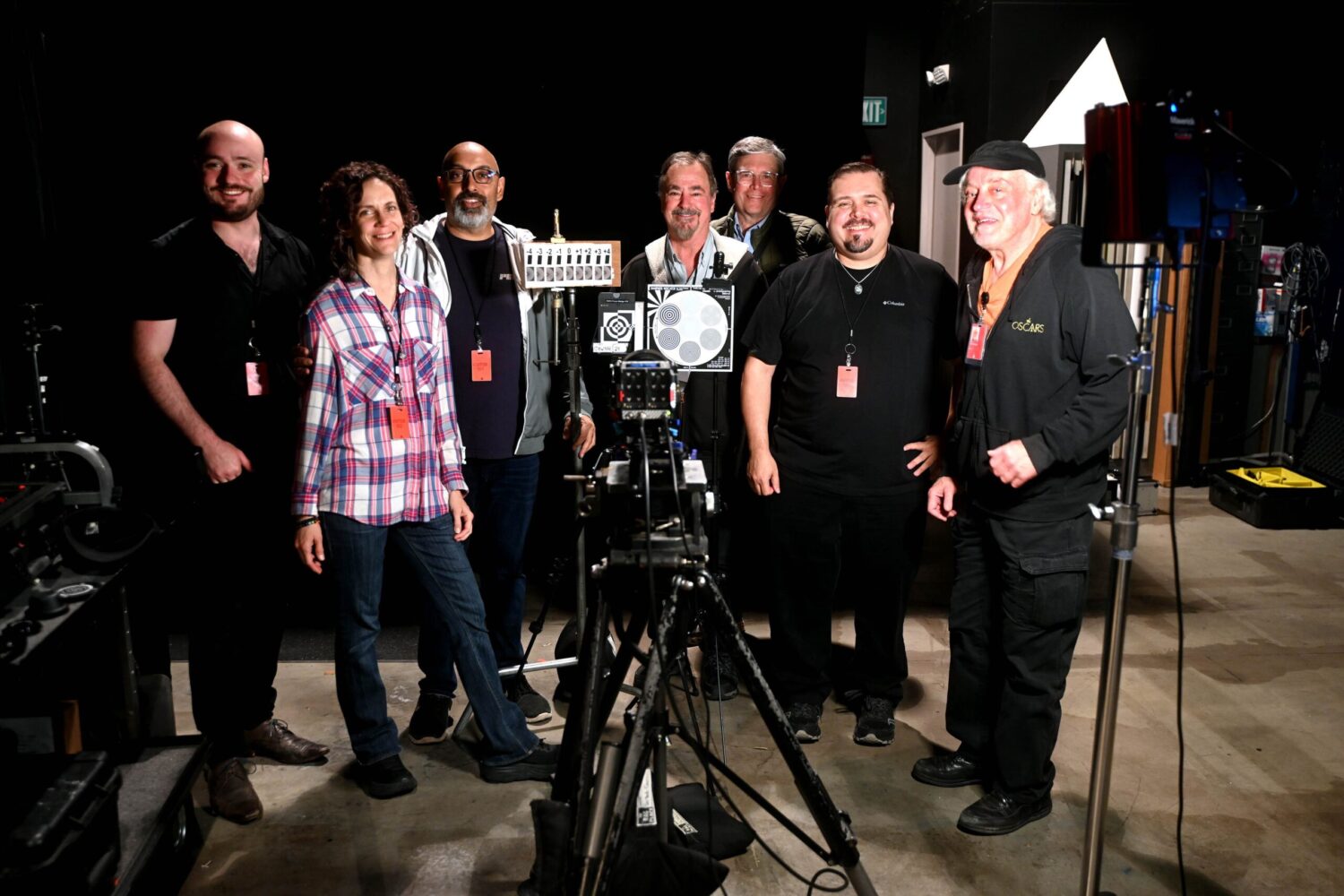SMPTE’s RIS-OSVP initiative team (L to R): Valentin P. Alt, AC/DIT; Danna Kinsky, camera assistant; Snehal Patel, director/producer at FearlessProductions.tv and committee leader for the Camera and Lens Metadata Committee; Dave Stump, ASC BVK; Rob Hummel, photographer; Phil Holland, cinematographer/image scientist; and Joe di Gennaro, stage.
The rapid rise of virtual production over the past five years has been nothing short of phenomenal. But as the technology continues to grow and mature, there will need to be more standardisation and consolidation, writes David Davies.
As recently as 12 months ago, it was possible to argue that the dramatic emergence of virtual production (VP) – the technology area that allows content producers to interactively visualise and create scenes in a studio environment – was without precedent in recent memory. Of course, that was just before it became truly apparent how transformative AI was going to be – on both our working and non-working lives, and in both positive and negative ways.
Nonetheless, the trajectory of VP has been – and continues to be – phenomenal. According to recent data from Grand View Research, the global VP market size was estimated at US$ 2.11 billion in 2023 and is on track to grow at a compound annual growth rate (CAGR) of 18.6% from 2024 to 2030. Moreover, this will be played out against an increasingly global background of adoption; the US remains the largest market, but Europe is growing fast and now Asia-Pacific is forecast to have the highest CAGR for the next six years.
Simultaneously, the pace of innovation is – if anything – continuing to accelerate in both hardware and software development. LED video wall screens – employed for real-time background visuals during internal shoots – as well as integrated virtual camera systems and motion capture workstations are among the types of hardware where the rate of new launches remains frenetic. And as with so many other prior tech trends in broadcast and media, increased competition and a greater attention to the full span of productions and budgets (ie. not just the top-tier movie projects that initially championed the technology) is rendering VP increasingly accessible to all content creators. This is a development highlighted and welcomed by many of the vendors interviewed in the new edition of Productionº360 digital magazine.
The outlook in software is arguably even more tantalising. As several of our interviewees indicate, the initial dominance of software platforms drawn from the gaming industry is unlikely to be open-ended. New players are coming into the space with what we might label ‘VP-first’ solutions that could prove to be more customisable to the requirements of film and TV production. With Artificial Intelligence (AI) and Machine Learning (ML) bound to have an increasing impact on software capabilities, the next few years of VP software development are set to be extremely exciting.
But for all of the huge potential afforded by VP, there are also some attendant challenges that will have to be addressed with some urgency if the technology is to continue maturing successfully.
THE TYRANNY OF CHOICE?
On one hand, the advent of new players in the market is brilliant news for overall levels of innovation and availability of creative options. On the other, there is a distinct danger that – in an area of the market that is still incredibly young in relative terms – the amount of choice becomes so great that content producers simply don’t know which way to turn. This could become especially apparent if, as anticipated by some observers, the underlying software becomes more niche and oriented towards specific types of production.
In this case, it could well be that the inherent tides of the marketplace provide something of a resolution. A phase of consolidation tends to occur after a few years in any significant new area of technology, and judging by some sources it seems this could already be underway in VP. As Grand View Research notes, “the level of M&A [mergers and acquisitions] activities in the market is rising significantly.” Meanwhile, the close relationships between technology giants and creative studios is enhancing “the advancements in [VP], subsequently fuelling increased consolidation of the market.”
Greater diversity of technology is also tied to another growing challenge: the need for technical standardisation. We do not have to reach too far into M&E’s past to locate examples of tech movements that have been held up by interoperability issues. The impact of ST 2110 on the adoption of IP-based workflows has been so positive that it can be easy to forget the difficult – and highly unpredictable – years that preceded it. In a market that had sometimes seemed intractably diffuse, the guaranteed level of interoperability provided by standardisation has brought significant cohesion to the market, and ensured that IP now stands poised to reach its full potential worldwide.
Now we need to see the same kind of trajectory occur in VP. The newness and complexity of the market mean this will be far from easy, but without greater interoperability it’s possible that VP could eventually hit a ceiling in some areas of production, especially at the middle and lower tiers.
Here, too, there is some cause for optimism as a number of standardisation programmes are underway. One notable example is the SMPTE Rapid Industry Solutions, On-Set Virtual Production (RIS-OSVP) initiative, which was established in 2021 to devise interoperability specifications, workflows and best practices for the industry, along with supporting educational courses and webcasts. Underlining the widespread observation (including in this issue) that standardisation of camera and lens metadata is a top priority, the initiative recently undertook a camera and lens measurement study to test and validate the optical model for accurately determining the circle of confusion and the near and far focus planes.
AGENT OF CHANGE
There are other challenges to be attended to – although in several of these, VP can also be a real agent of change. Environmental impact is one such area; at the moment, data about VP’s carbon output is relatively scarce, beyond the obvious parameter of its ability to significantly reduce the amount of travel associated with location filming. However, the newness of the technology means there is huge potential to put in place rigorous and universal carbon reporting from an early stage – ensuring that not only is its specific impact comprehensively understood, but that its lessons can be implemented elsewhere.
Ultimately, these are not insurmountable challenges and with more collaboration and collective action – which does now seem to be emerging – there is reason to hope many of them will be partially resolved in the next few years. They also shouldn’t be allowed to overshadow a phenomenal story of technological progress whose presence is felt in all of the Q&As that make up the remainder of this issue.
Single page full-screen view link for mobile devices
https://bit.ly/Production360-V1-2
Double-page full-screen view link
https://bit.ly/Production-360-V1-2





